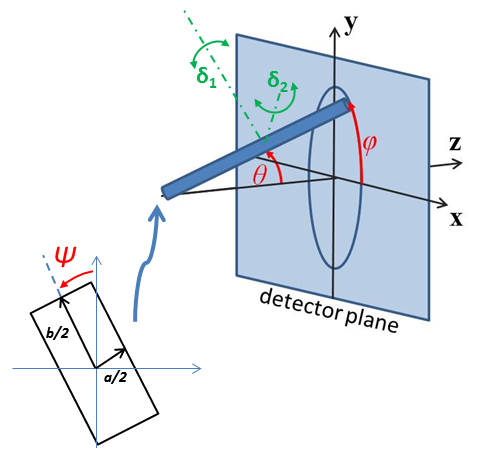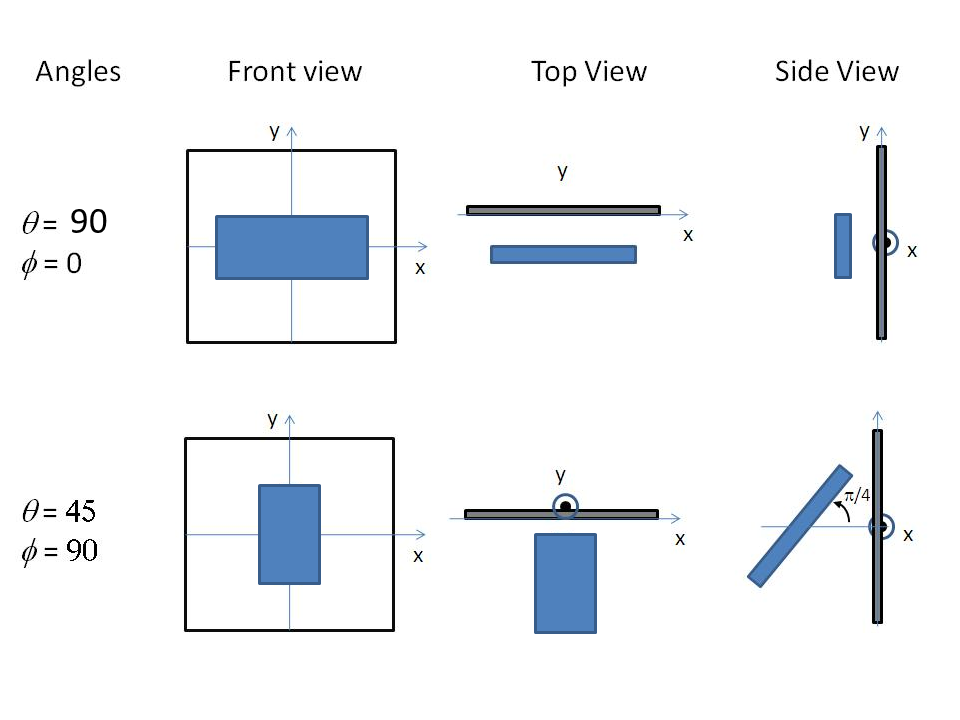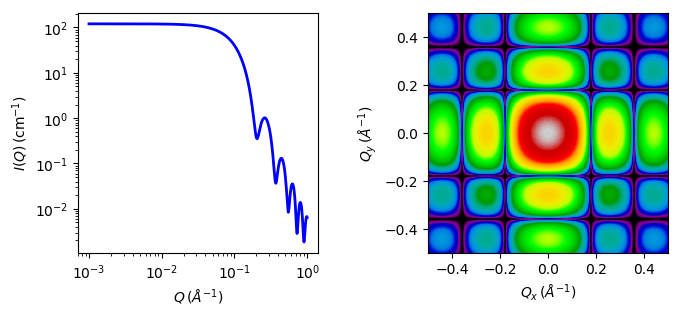rectangular_prism
Rectangular parallelepiped with uniform scattering length density.
| Parameter | Description | Units | Default value |
|---|---|---|---|
| scale | Scale factor or Volume fraction | None | 1 |
| background | Source background | cm-1 | 0.001 |
| sld | Parallelepiped scattering length density | 10-6Å-2 | 6.3 |
| sld_solvent | Solvent scattering length density | 10-6Å-2 | 1 |
| length_a | Shorter side of the parallelepiped | Å | 35 |
| b2a_ratio | Ratio sides b/a | None | 1 |
| c2a_ratio | Ratio sides c/a | None | 1 |
| theta | c axis to beam angle | degree | 0 |
| phi | rotation about beam | degree | 0 |
| psi | rotation about c axis | degree | 0 |
The returned value is scaled to units of cm-1 sr-1, absolute scale.
This model provides the form factor, P(q), for a rectangular prism.
Note that this model is almost totally equivalent to the existing parallelepiped model. The only difference is that the way the relevant parameters are defined here (a, b/a, c/a instead of a, b, c) which allows use of polydispersity with this model while keeping the shape of the prism (e.g. setting b/a=1 and c/a=1 and applying polydispersity to a will generate a distribution of cubes of different sizes).
Definition
The 1D scattering intensity for this model was calculated by Mittelbach and Porod (Mittelbach, 1961), but the implementation here is closer to the equations given by Nayuk and Huber (Nayuk, 2012). Note also that the angle definitions used in the code and the present documentation correspond to those used in (Nayuk, 2012) (see Fig. 1 of that reference), with θ corresponding to α in that paper, and not to the usual convention used for example in the parallelepiped model.
In this model the scattering from a massive parallelepiped with an orientation with respect to the scattering vector given by θ and ϕ
where A, B and C are the sides of the parallelepiped and must fulfill A≤B≤C, θ is the angle between the z axis and the longest axis of the parallelepiped C, and ϕ is the angle between the scattering vector (lying in the xy plane) and the y axis.
The normalized form factor in 1D is obtained averaging over all possible orientations
And the 1D scattering intensity is calculated as
where V is the volume of the rectangular prism, ρp is the scattering length of the parallelepiped, ρsolvent is the scattering length of the solvent, and (if the data are in absolute units) scale represents the volume fraction (which is unitless).
For 2d data the orientation of the particle is required, described using angles θ, ϕ and Ψ as in the diagrams below, for further details of the calculation and angular dispersions see Oriented particles . The angle Ψ is the rotational angle around the long C axis. For example, Ψ=0 when the B axis is parallel to the x-axis of the detector.
For 2d, constraints must be applied during fitting to ensure that the inequality A<B<C is not violated, and hence the correct definition of angles is preserved. The calculation will not report an error, but the results may be not correct.

Fig. 72 Definition of the angles for oriented core-shell parallelepipeds. Note that rotation θ, initially in the xz plane, is carried out first, then rotation ϕ about the z axis, finally rotation Ψ is now around the axis of the cylinder. The neutron or X-ray beam is along the z axis.

Fig. 73 Examples of the angles for oriented rectangular prisms against the detector plane.
Validation
Validation of the code was conducted by comparing the output of the 1D model to the output of the existing parallelepiped model.

Fig. 74 1D and 2D plots corresponding to the default parameters of the model.
Source
rectangular_prism.py
⋆ rectangular_prism.c
⋆ gauss76.c
References
- P Mittelbach and G Porod, Acta Physica Austriaca, 14 (1961) 185-211
- R Nayuk and K Huber, Z. Phys. Chem., 226 (2012) 837-854
- Onsager, Ann. New York Acad. Sci., 51 (1949) 627-659
Authorship and Verification
- Author:
- Last Modified by:
- Last Reviewed by: